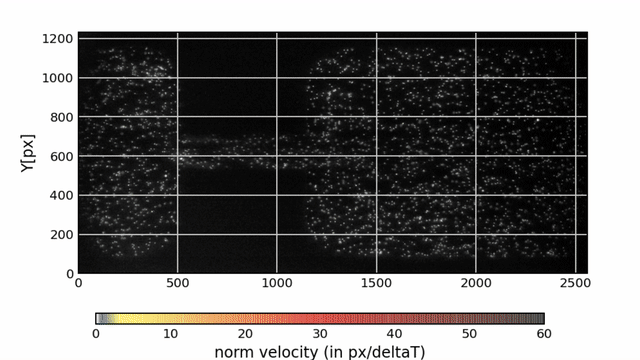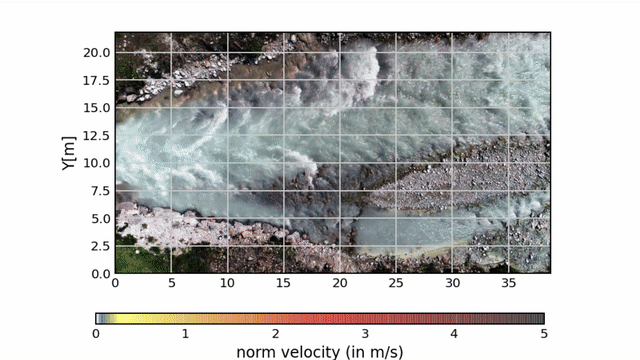OpyFlow : Python package for Optical Flow measurements
Opyflow is a basic image velocimetry tool to simplify your video or frame sequences processing.
It is based on opencv and vtk libraries to detect Good Features to Track (GFT), calculate their displacements by the Lukas Kanade method and interpolate them on a mesh. This method is sometimes called Feature Image Velocimetry or Feature Tracking. It is an alternative to the classical cross-correlation techniques employed in Particle Image Velocimetry (PIV). Compared to this technique, GFT+OpticalFlow may result in better performance when image qualities are poor for velocimetry, i.e. when velocity information on frames is non-uniform.
For flow calculations, the process is mainly inspired by the openCV python sample lktrack.py.
The package also contains some rendering tools built with matplotlib. Velocities can be exported (csv, tecplot, vtk, hdf5).
Author: Gauthier Rousseau
Corresponding e-mail : [email protected]
To quickly get started with OpyFlow, follow these steps:
-
Ensure you have Python installed in your environment.
-
Open your terminal and run the following command to install OpyFlow and its main dependencies (matplotlib, vtk, and opencv):
pip install opyf
Alternatively, if you have the OpyFlow repository cloned locally, you can run:
python3 -m pip install ./
-
This will automatically install the OpyFlow library and its dependencies.
To analyze a frame sequence (e.g., PNG, BMP, JPEG, TIFF), use the following code:
import opyf
analyzer = opyf.frameSequenceAnalyzer("folder/toward/images")For analyzing a video (e.g., MP4, AVI, MKV), use the following code:
analyzer = opyf.videoAnalyzer("video/file/path")To perform your first analysis, run the following code:
analyzer.extractGoodFeaturesAndDisplacements()OpyFlow package includes two frames and one video for testing and self-practice:
-
The two frames were extracted from the frame sequence of the Test case A of the PIV Challenge 2014:
When applied to the entire dataset, OpyFlow can produce the above result (see Test PIV Challenge 2014 - Case A for details on the procedure).
-
The video is a bird's eye view video of a stream river taken by a drone, from which surface velocities can be extracted (see this tutorial for different possible procedures or the following python file):
-
A guide is also provided to obtain the free surface velocity in a river from two amateur videos:
Stabilization, orthorectification (bird's eye view transformation), and free surface velocity estimation on the Brague river with OpyFlow
This repository is organized as follows:
The setup file:
- setup.py
The package Folder opyf:
-
opyf
- Analyzer.py
- Track.py
- Interpolate.py
- Files.py
- Filters.py
- Render.py
- Tools.py
- custom_cmap.py (based on Chris Slocum file)
-
test
- Test_case_PIV_Challenge_2014
- Test_land_slide_youtube_video
- Test_Navizence
- Test_Brague_flood
A test on synthetic images is still required.
The package requires python and basic python package: csv, numpy, matplotlib, tqdm, hdf5. Main dependencies are: OpenCV and VTK.
If the pip install opyf command above does not work for you, an alternative way to deal with dependencies is using miniconda or anaconda.
When miniconda/anaconda is installed you may create an environment (here called opyfenv). To create the environment type in the terminal:
conda create -n opyfenv python=3.11This command line will install an environment with python 3.11 and the main dependencies.
You can access to your environment by typing:
conda activate opyfenvYou can also use the standard python protocol (run the command where you want to put the environment):
python -m venv opyfenv
source opyfenv/bin/activateFrom you environment, you should be able to install opyf with pip install opyf.
For development mode, you may also install the libraries individually with pip:
pip install ipython vtk opencv-python tqdm h5py matplotlib scipy ipykernel PyQt6And set the opyf repository in your PATH or in the beginning of your python script using:
import sys
sys.path.append("path/toward/opyf/src")Tested on:
- Python: 3.11
- VTK: 9.2.6
- OpenCV: 4.7
- NumPy: 1.24
- Matplotlib: 3.7.1
This package has been developed in the course of my PhD at EPFL to study Turbulent flows over rough permeable beds. Outputs are visible in the manuscript as well as in this Video where paraview animations have been rendered thanks to opyf outputs.
@PhdThesis{rousseau2019turbulent, title={Turbulent flows over rough permeable beds in mountain rivers: Experimental insights and modeling}, author={Rousseau, Gauthier}, year={2019}, institution={EPFL} }
An article published in Experiments in Fluids is available in Open Access : Scanning PIV of turbulent flows over and through rough porous beds using refractive index matching
Follow this link to directly access to the annex of the article presenting the opyf algorithms and tests.
@article{rousseau2020scanning, title={Scanning PIV of turbulent flows over and through rough porous beds using refractive index matching}, author={Rousseau, Gauthier and Ancey, Christophe}, journal={Experiments in Fluids}, volume={61}, number={8}, pages={1--24}, year={2020}, publisher={Springer} }
Contributors : Hugo Rousseau, Mohamed Nadeem, LHE team and others
Credits for UAV video : Bob de Graffenried
Credits for 2019 flood video on Brague River (Biot, French Riviera) : Pierre Brigode


